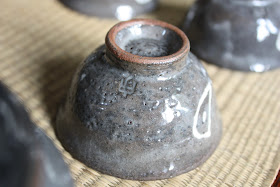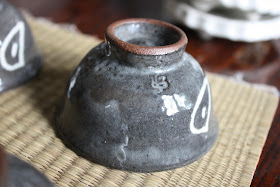Hot water passes from the serving pot and into the cups to warm them. Its stream contact the bottom of the cup- the water poured from a short distance echos peace. The cups are each filled 1/3 with water and left until they become warm. They are purposefully picked up with the right hand and brought to the dan tian where they symbolically contact the purity of the white hemp cleaning cloth held in the left hand. The hot water is slowly tilted towards the distant edge of the cup and then slowly angled clockwise around the lip of the cup. This clockwise direction indicates a filling of the cup with energy and creating energetic space for the tea which will so arrive here. Obviously, it is also done to warm the full inside surface area of each cup.
The hot water is then poured into the dirty water bowl, the small bead of water is wiped away with the pure white hemp cloth, and the cup makes its way back on to the table. This exact routine is now completed with the other two cups.
When the tea is prepared and poured into the serving pot from the teapot it makes its way into the cup closest and furthest left to the person preparing tea. The sound of the tea hitting the empty, warm cups now sound even more peaceful than just minutes later. The tea is poured from a short distance from each cup creating a sound that resembles a trickling stream. Pouring too fast, this sound and feeling is lost and a hurried feeling is added to the tea room. Pouring too slow, this sound and feeling is also lost and a stagnant over-restrained feeling is added to the tea room.
Half of the first cup is poured, then half of the second cup, the cup above or to the immediate right of the first cup, then the third cup is fully filled, the second cup is then topped up, then the first topped up. A few small bubbles float softly on the surface of the liquid.
The white of the inside of the cup represents the purity or reverence that we show to the tea- it the surface contacting the tea. It is the purity and peace which we all strive for while drinking tea, the peace inside us. In the ChaSinJeon white cups are best for drinking tea so that the full colour of tea can be fully appreciated. The inside of each cup is crackled and stained from the tea oils, each also has small air holes. This is each cup's fingerprint, its impression on us, on our tea experience.
It is glazed with a simple grey fieldspar glaze on the outside representing the modesty we should project outwardly when enjoying tea. Each cup has the pictograph of a moon, a yin symbol. The functions of cups are too hold, a yin function. Reminding us of our inner nature and quietude as we sip from its insides.
Peace











Matt, I absolutely loved this post. The whole description sounded so peaceful and serene. I never thought to actually sit and listen carefully to the tea pour.
ReplyDeleteInterestingly enough, I use the same technique you described with the clock-wise pour from the teapot/gaiwan into the hulu; going from the top, and spiraling down slowly.
Gorgeous little cups shown! I'm sure they glow with your explicit attentions.
Centranthus,
ReplyDeleteThanks for your kind words.
The clockwise dirrection in the tea ceremony usually strenthens and prepares while the counter clockwise dirrection usually removes and finishes.
Peace